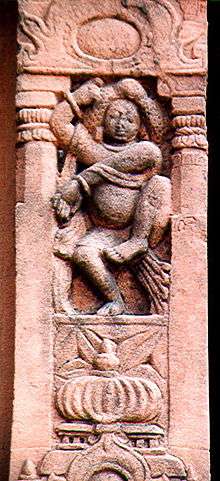Gana
The word gaṇa (/ˈɡʌnə/; Sanskrit: गण) in Sanskrit and Pali means "flock, troop, multitude, number, tribe, category, series, or class". It can also be used to refer to a "body of attendants" and can refer to "a company, any assemblage or association of men formed for the attainment of the same aims". The word "gana" can also refer to councils or assemblies convened to discuss matters of religion or other topics.

In Hinduism, the Gaṇas are attendants of Shiva and live on Mount Kailash. Ganesha was chosen as their leader by Shiva, hence Ganesha's title gaṇeśa or gaṇapati, "lord or leader of the ganas".[1]
As Shiva's attendants
.jpg)
In Hinduism, the gana are attendants who reside in chthonic and liminal locations such as cemeteries and charnel grounds. The gana also attend Shiva on Mount Kailash. The story of creation of Virabhadra from Shiva's lock and the destruction of Daksha by Virabhadra and his ganas are popular stories from the Puraṇas.
As assemblies
Many books of Sanskrit literature used ganas and sanghas.
Pāṇini in his Sanskrit grammar used gana as:
- संघोद्घौ गण प्रशंसयो Sanghoddhau gaṇa praśansayo
The Nāradasmṛti in Sanskrit mentions:
It shows that the ganatantra (republic) system of rule was prevalent in India since ancient times.
In Shanti Parva
A detailed analysis of the GANAS obtains in chapter 108 of Shanti Parva in which Yudhishthira asks Bhishma about the ganas: how do they increase, how do they defend themselves from the dividing-policy of enemies, what are their techniques in conquering enemies and in making friends, how do they hide their secret mantras. Bhishma's answers to these questions were recorded in the form of shlokas (verses) from 16 – 32 in Shanti Parva.[2]
In Vedas
Ganas were narrated in Vedas in the form of assemblies of warriors as is clear from the following sutras of Rigveda (RV 3-26-6):
- व्रातं व्रातं गणम् गणम् Vrātam Vrātam gaṇam gaṇam
Ganatantra (republic) means a state run by assemblies.
The representative members of clans were known as ganas and their assembly as sanghas, there chief as ganadhipati or Ganesha and Ganapati.
Sangam literature
Sangam literature of Tamil (c. 300 BCE – c. 300CE) describes the offerings for Ganas. In Silapathikaram one of the five epics of Tamil by Ilango Adigal saying the offering for eighteen kind of Ganas.[3]
In Buddhist literature
The Buddhist literature Mahabagga mentions that:
- गण पूरकोवा भविस्सामीति Gaṇa pūrkovā bhavissāmīti
It indicates that an officer used to see the number of ganas and their koram in the Rajasabha (state assembly).
Buddhist books like ‘Pali-pitaka’, Majjhamnikaya, mahabagga, Avadana shataka mentioned ganas and sanghas. During Buddha's period India had 116 republics or ganasanghas. In Buddhist times, Gaṇas were assemblies of the Sanghas, early democratic republics known as Gaṇa-rājyas, literally "rule of the assembly", a term paralleling demo-kratia or soviet republic. The term was revived in Bhārata Gaṇarājya, the official name of the Republic of India.
Buddhaghosa mentions (MA.ii.737) the palaces of the Ganadeva-puttas ("Ganadevaputtānañ ca vimānāni") among those seen by King Nemi as Mātali led him through the world of the devas. This term seems to be absent in the corresponding Jātaka.[4] It is possible that these deities are associated with the Gaṇas of Hinduism.
See also
| Wikimedia Commons has media related to Gana (Indian religions). |
References
- Dictionary of Hindu Lore and Legend (ISBN 0-500-51088-1) by Anna L. Dallapiccola
- Mahabharata in Sanskrit, Book-12, Ch. 108
- Silappadikaram by S. Krishnamoorthy. p. 35.
- "Ganadevaputtā". Buddhist Dictionary of Pali Proper Names. Retrieved 2019-04-27.
